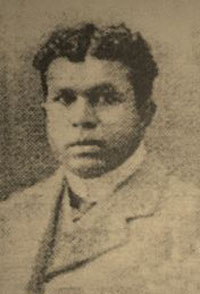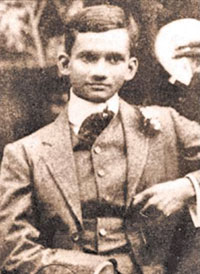75th Independence
A dark period under British rule
View(s):- Declaration of Martial Law in 1915
By Priyasath Dep

Edmund Hewavitarne
The Government Agent, since 1900, when issuing permits under the Police Ordinance for religious processions imposed a condition that when passing places of religious worship all forms of music should stop. This led to resentment on the part of the Sinhala Buddhists who thought that these conditions were imposed for the benefit of the Muslims who in the recent past had constructed new mosques along the routes traditionally used for religious possessions.
In 1914, the Basnayake Nilame of Walahagoda Temple filed an action in the District Court of Kandy against the Attorney General. It was alleged that the Government Agent by imposing conditions on religious processions violated Article 5 of the Kandyan Convention which stated that ‘the religion of Buddha professed by the Chiefs and other inhabitants of these provinces is declared inviolable and its rites, ministers and places of worship are to be maintained and protected.’ District Judge of Kandy, Paul E. Peiris held with the Basnayake Nilame. The Attorney General at the instance of the Government Agent filed an appeal to the Supreme Court against the judgment of the District Court. The Supreme Court set aside the judgment of the District Court and held that under Police Ordinance of 1865 and Local Boards Ordinance of 1898, the Government Agent could impose conditions when issuing permits.
The Sinhalese Buddhists were disappointed and considered the judgment as a defeat while the Muslims saw it as a victory. The Muslims again started to object to Buddhist processions and as a result conditions were imposed regarding the conduct of processions. This angered the Sinhala Buddhists and increased their antipathy towards Muslims.
P. B. Wadugodapitiya and James Silva filed two separate applications seeking permission for their carts to go in procession carrying carol singers (Bakthi Gita) on May 28 associated with Vesak celebrations. The Muslims feared that there would be serious trouble and complained to the Superintendent of Police Tranchell who summoned both applicants and gave instructions that they should stop music within 100 yards of the mosque.

Edward Henry Pedris
In the early hours at about 1.30 a.m., both carts forcibly entered the Castle Hill Street followed by a large crowd and when passing the mosque attacked it with stones and sticks and entering the mosque, damaged the hanging lamps and windows. In Colombo Street, Moors from upstairs of the boutiques threw bottles at the crowd. This angered the crowd that started to attack Muslim houses, shops and boutiques causing extensive damage. One Kira was killed as a result of firing by the Muslims. SP Tranchell arrived at the scene and made some arrests, dispersed the crowd and brought the situation under control.
On May 29, villagers from surrounding areas gathered near the Dalada Maligawa on hearing that Muslims were trying to attack the Maligawa. Violence erupted again in Kandy. However, police managed to bring the situation under control.
In the midst of the violence, rumours were circulating that Muslims were attacking temples and churches and molesting Sinhala women.
On May 31, the riots spread to Sabaragamuwa and North Western Provinces and then to the Western and Southern provinces.
It was proved that the police and civil administration failed to quell the riots. This was attributed to various factors. Police inaction in certain areas and in other areas, that they did not have sufficient strength to suppress the riots. Though they were armed with firearms they could not use them, as the magistrates were reluctant to issue orders to fire. The mobs were aware of this and retaliated by attacking police patrols and in certain instances rescued the suspects arrested by the police.
Declaration of martial law
As the police and civil administration failed to suppress the riots and restore law and order, the Governor decided to declare martial law in the Western Province and Sabaragamuwa on June 2, 1915. On June 3 martial law was proclaimed in the Central, Southern and North Western Provinces. It was extended to Uva and North Central Province on June 18.
With the declaration of martial law, the military replaced the civil authorities and was responsible for the maintenance of law and order. The Brigadier General Malcolm, Officer Commanding the Troops in Ceylon was the head of the military establishment ably assisted by Captain Northcote, Deputy Acting Adjutant General.
Martial law is generally declared in occupied territories. In territories administered by the government, martial law is declared when there is an insurrection, rebellion or civil war. In such a situation, force is met with force and repressive measures are taken to suppress the disturbances and the inhabitants are treated as enemies. The military and Punjabis terrorised the villagers, arrested and detained large numbers and extracted confessions. The Sinhalese were intimidated to admit responsibility and pay compensation to the victims. Suspects were hurriedly tried in military tribunals and in some cases, suspects were sentenced to death. There were glaring instances of miscarriage of justice such as the execution of Edward Henry Pedris and sub inspector Samarasinghe and the case against Edmund Hewavitarne who was sentenced to penal servitude for life. They were charged with offences committed before the declaration of martial law and should have been tried in regular courts where they could have vindicated their innocence. There were several cases of summary execution.
This period was referred to as a ‘Reign of Terror’. E. W. Perera and Ponnambalam Ramanathan went to London carrying with them a Memorandum seeking withdrawal of the martial law and to release the Sinhalese kept in detention indefinitely without trial. They met the Secretary in Charge of Colonies and presented the Memorandum.
During martial law Sinhala leaders were incarcerated and money was extracted from wealthy Sinhalese. Most of them had nothing to do with the riots. The Temperance Movement and Sinhala nationalism was suppressed to such an extent that it took several decades for the movements to emerge as a force to reckon with. Therefore, the struggle for independence like in India did not become a mass movement. It was left to the western educated elites to negotiate with the British and gain independence.
(Justice Priyasath Dep is a former Chief Justice of Sri Lanka and one-time Attorney General of the Republic. He is the son of the late Mr A. C. Dep who was a Deputy Inspector General of Police and author of the book; ‘Ceylon Police and the Sinhala-Muslim Riots of 1915′).

